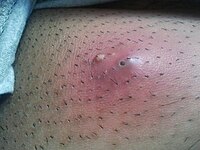
Photo from wikipedia
Purpose The aim of this study was, firstly, to determine the concordance of ultrasonographic and histopathological diagnoses in patients in whom apical resection was already indicated. Secondly, this study aimed… Click to show full abstract
Purpose The aim of this study was, firstly, to determine the concordance of ultrasonographic and histopathological diagnoses in patients in whom apical resection was already indicated. Secondly, this study aimed to determine whether lesions were periapical granulomas or cysts, and to compare them after root canal treatment using ultrasonography and periapical radiographs. Materials and Methods In the first stage of the study, ultrasonographic and histopathologic diagnoses of 10 lesions were compared. Secondly, the periapical radiographs and ultrasonographic images of 44 lesions were measured. The presence of internal vascularity was determined by ultrasonographic color and power Doppler modes. Follow-up examinations of healing after root canal treatment were performed using ultrasonography and periapical radiographs, and these modalities were compared. Results In the periapical granuloma and cyst groups, the measurement values decreased for all variables. There was no significant difference in the dimensional changes of lesions between the 2 groups, and ultrasonography and periapical radiographs were compatible. The pre-diagnoses were compared with histopathological diagnoses and were found to be compatible. Conclusion The ultrasonographic color and power Doppler techniques could be an effective method for diagnosing periapical lesions as cysts or granulomas. After root canal treatment of granulomas and cysts, the dimensional shrinkage and healing patterns appear to be similar. Ultrasonography and periapical radiographs were consistent in terms of dimensional comparisons, and ultrasonography may be an alternative method for follow-up of the healing of periapical lesions.
Journal Title: Imaging Science in Dentistry
Year Published: 2022
Link to full text (if available)
Share on Social Media: Sign Up to like & get
recommendations!